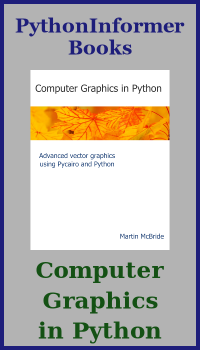Regular polygons in generativepy
Categories: generativepy generativepy tutorial

This tutorial shows how to create regular polygons in generativepy, using the RegularPolygon class.
Here are some related tutorials that contain useful information about other features this tutorial uses:
- Fill and stroke tutorial - how we fill and outline shapes.
- Circle tutorial - how to make circles (we use circles to illustrate inner and outer radius in this tutorial).
- Polygons tutorial - how to make some other types of polygons.
RegularPolygon example code
Here is the code to show some of the features of RegularPolygon:
from generativepy.drawing import make_image, setup
from generativepy.color import Color
from generativepy.geometry import RegularPolygon, Circle
import math
def draw(ctx, pixel_width, pixel_height, frame_no, frame_count):
setup(ctx, pixel_width, pixel_height, background=Color(0.8))
red = Color('crimson')
green = Color('darkgreen')
blue = Color('dodgerblue')
RegularPolygon(ctx).of_centre_sides_radius((150, 150), 5, 100)\
.fill(blue)\
.stroke(green, 5)
RegularPolygon(ctx).of_centre_sides_radius((400, 150), 6, 100)\
.fill(blue)\
.stroke(green, 5)
RegularPolygon(ctx).of_centre_sides_radius((650, 150), 6, 100, math.pi/12)\
.fill(blue)\
.stroke(green, 5)
p = RegularPolygon(ctx).of_centre_sides_radius((150, 400), 5, 100)\
.fill(blue)\
.stroke(green, 5)
Circle(ctx).of_center_radius((150, 400), p.inner_radius).stroke(red, 5)
p = RegularPolygon(ctx).of_centre_sides_radius((400, 400), 5, 100)\
.fill(blue)\
.stroke(green, 5)
Circle(ctx).of_center_radius((400, 400), p.outer_radius).stroke(red, 5)
p = RegularPolygon(ctx).of_centre_sides_radius((650, 400), 5, 100)\
.fill(blue)\
.stroke(green, 5)
for v in p.vertices:
Circle(ctx).of_center_radius(v, 10).fill(red)
make_image("regularpolygons-tutorial.png", draw, 800, 550)
This code is available on github in tutorial/shapes/regularpolygons.py.
Here is the resulting image:

We will examine this code in the sections below.
Drawing basic regular polygons
This section of the code draws the two polygons in the top left of the image:
RegularPolygon(ctx).of_centre_sides_radius((150, 150), 5, 100)\
.fill(blue)\
.stroke(green, 5)
RegularPolygon(ctx).of_centre_sides_radius((400, 150), 6, 100)\
.fill(blue)\
.stroke(green, 5)
This code creates two polygons with:
- A suitable centre point to position them on the page.
- 5 sides (pentagon) and 6 sides (hexagon).
- Radius of 100 to set the size.
- Filled in blue and outlined in green.
Notice that both shapes have horizontal bases.
Drawing a rotated polygon
This code draws the hexagon in the top left of the image:
RegularPolygon(ctx).of_centre_sides_radius((650, 150), 6, 100, math.pi/12)\
.fill(blue)\
.stroke(green, 5)
This is drawn in the same way as the previous hexagon, but with an angle of math.pi/12 radians (15 degrees). This rotates the shape 15 degrees clockwise about its centre, so the base is no longer horizontal.
Drawing an inner circle
This code draws the same pentagon as before, but with an inner circle (bottom left of the main image):
p = RegularPolygon(ctx).of_centre_sides_radius((150, 400), 5, 100)\
.fill(blue)\
.stroke(green, 5)
Circle(ctx).of_center_radius((150, 400), p.inner_radius).stroke(red, 5)
When we draw the pentagon, we also store the RegularPolygon object as p.
We then draw a circle. The circle has the same centre as the polygon, and a radius equal to the inner radius of the polygon. This is obtained from p.inner_radius.
The circle just fits inside the polygon.
Drawing an outer circle
This code draws the same pentagon as before, but with an outer circle (bottom centre of the main image):
p = RegularPolygon(ctx).of_centre_sides_radius((400, 400), 5, 100)\
.fill(blue)\
.stroke(green, 5)
Circle(ctx).of_center_radius((400, 400), p.outer_radius).stroke(red, 5)
This time, the circle has the same centre as the polygon, and a radius equal to the outer radius of the polygon. This is obtained from p.outer_radius.
The polygon just fits inside the circle.
Drawing the vertices
This code draws the same pentagon as before, but marks each corner with a dot (bottom right of the main image):
p = RegularPolygon(ctx).of_centre_sides_radius((650, 400), 5, 100)\
.fill(blue)\
.stroke(green, 5)
for v in p.vertices:
Circle(ctx).of_center_radius(v, 10).fill(red)
We draw the polygon as usual.
Then we use p.vertices to get the corners of the polygon. This returns a tuple of five coordinates (x, y) corresponding to the five vertices of the pentagon.
We loop over those vertices, and for each one we draw a small red-filled circle, radius 10, centred on the vertex. This draws a red dot at each corner of the pentagon.
Related articles
- Polygons in generativepy
- Circles and ellipses in generativepy
- Bezier curves in generativepy
- Fill and stroke in generativepy
- Stroke styles in generativepy
- Fill styles in generativepy
- Text in generativepy
- Text offset in generativepy
- Text metrics in generativepy
- Composite paths in generativepy
- Complex paths in generativepy
- Images in generativepy
- Geometric markers in generativepy
- Path objects in generativepy
- Turtles in generativepy
Join the GraphicMaths/PythonInformer Newsletter
Sign up using this form to receive an email when new content is added to the graphpicmaths or pythoninformer websites:

Popular tags
2d arrays abstract data type and angle animation arc array arrays bar chart bar style behavioural pattern bezier curve built-in function callable object chain circle classes close closure cmyk colour combinations comparison operator context context manager conversion count creational pattern data science data types decorator design pattern device space dictionary drawing duck typing efficiency ellipse else encryption enumerate fill filter for loop formula function function composition function plot functools game development generativepy tutorial generator geometry gif global variable greyscale higher order function hsl html image image processing imagesurface immutable object in operator index inner function input installing integer iter iterable iterator itertools join l system lambda function latex len lerp line line plot line style linear gradient linspace list list comprehension logical operator lru_cache magic method mandelbrot mandelbrot set map marker style matplotlib monad mutability named parameter numeric python numpy object open operator optimisation optional parameter or pandas path pattern permutations pie chart pil pillow polygon pong positional parameter print product programming paradigms programming techniques pure function python standard library range recipes rectangle recursion regular polygon repeat rgb rotation roundrect scaling scatter plot scipy sector segment sequence setup shape singleton slicing sound spirograph sprite square str stream string stroke structural pattern symmetric encryption template tex text tinkerbell fractal transform translation transparency triangle truthy value tuple turtle unpacking user space vectorisation webserver website while loop zip zip_longest
